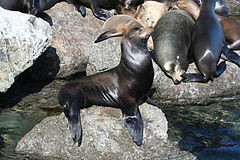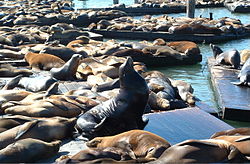California sea lion
| California Sea Lion | |
|---|---|

| |
| Scientific classification | |
| Kingdom: | |
| Phylum: | |
| Class: | |
| Order: | |
| Suborder: | |
| Family: | |
| Subfamily: | |
| Genus: | Zalophus Gill, 1866
|
| Species: | Z. californianus
|
| Binomial name | |
| Zalophus californianus (Lesson, 1828)
| |
The California Sea Lion (Zalophus californianus) is a coastal sea lion of the northern Pacific Ocean. They are probably the most common pinniped and can adapt to man-made environments. Their numbers are abundant and the population continues to expand at a rate of approximately 5.0% annually.[1] They are also quite intelligent and even adult males can be easily trained. Because of this, California sea lions are commonly used for entertainment in circuses, zoos and marine parks; and are used by the US Navy for certain military operations.
Physical description
Male California sea lions get up to 390 kg (858 lb) and 2.4 metres (8 ft) long, while females are significantly smaller, at 110 kg (240 lb) and 2 metres (6.5 ft) long.
Males grow a large crest of bone on the top of their heads as they reach sexual maturity, and it is this that gives the animal its generic name (loph is "forehead" and za- is an emphatic; Zalophus californianus means "Californian big-head"). Females are lighter in color than the males, and pups are born dark but lighten when they are several months old. When it is dry the skin is a chocolate brown colour.
Range and habitat
As its name suggests, the California sea lion lives mainly around the waters of California. It also lives around Oregon, Washington, and British Columbia to the north and Mexico and the Galápagos Islands to the south. These sea lions also lived in Japan but are believed to be extinct there.
California sea lions breed from the Channel Islands off Southern California, to Mexico. Major breeding sites are San Miguel and the San Nicolas islands. Non-breeding populations live as far north as British Columbia. The Galápagos subspecies breeds exclusively on the Galápagos Islands and rarely travels far. They also lived around Japan but are now believed to be extinct here.
California sea lions prefer to breed on sandy beaches in the southern part of their range. On warm days they stay close to the water's edge. At night or on cool days, the sea lions will move inland or up coastal slopes. They will also often gather at marinas and wharves, and may even be seen on navigational buoys. These man-made environments provide then safety from their natural predators: orcas and white sharks.
Food and foraging

California Sea Lions feed on a wide-variety of seafood, mainly squid and fish. Commonly eaten fish and squid species include salmon, hake, Pacific whiting, anchovies, herring, and market squid.[2] They feed mostly around the edge of the continental shelf as well as sea mounts, the open ocean and the ocean bottom. Average annual food consumption of males in zoo increased with age to stabilize at approximately 4,000 kg/year by the age of 10 years. Females showed a rapid increase in average annual food consumption until they were 3 years old. Thereafter, females housed outdoors averaged 1,800 kg/year.[3]
California sea lions may eat alone or in small to large groups depending on the amount of food available. They will cooperate with dolphins, sharks and seabirds when hunting large schools of fish. Sea lions from the state of Washington will wait at the mouths of river to for the salmon run. They also have learned to feed on steelhead, and white sturgeon below fish ladders at Bonneville Dam and at other locations in the Columbia River, Willamette River, and in Puget Sound.
Adult females forage between 10 and 100 km from the rookery, and dive to average depths of 31.1 to 98.2 m, with maximum dives between 196 and 274 m. They travel at an estimated speed of 10.8 km/h, and that young sea lions have an initial defecation time averaging 4.2 hours. Adult females spend 1.6-1.9 days on land and 1.7-4.7 days at sea.[4]
Lifestyle and reproduction

California sea lions are highly social and breed around May to June. When establishing a territory, the males will try to increase their chances of breeding by staying on the rookery for as long as possible. During this time, they'll fast and have to get their energy from their stored up blubber. Size is a key factor in winning fights and well as waiting. The bigger the male the more blubber he can store and the longer he can wait.
A male sea lion can only hold his territory for up to 27 days. Females don't become receptive until 21 day after the pups are born, thus the males do not set up their territories until after the females give birth. Most combat fights occur during this time. Soon, the fights go from violent combat to ritualized displays such as barking, head-shaking, stares and bluff lunges. There can be as may as 16 females for one male.
The females have a 12-month gestation period and give birth around June and August. Mothers may give birth on land or in water. The pups are born with their eyes open and can vocalize with their mothers. Pups may nurse for up to six months and grow rapidly due to the high fat content in the milk. California Sea Lions are the only mammals whose milk does not contain lactose. At about two months the pups learn to swim and hunt with their mothers.

After the breeding season, female California sea lions normally stay in southern waters while the adult males and juveniles migrate north for the winter.
Human interactions

California sea lions are intelligent and adaptable, and are often trained as entertainers at marine parks, zoos, and circuses; as well as by researchers studying interspecies cooperation in the marine environment. They are also used in military applications as sentries, and for equipment recovery, by the U.S. Navy Marine Mammal Program.[5]
California sea lions are protected under the U.S. Marine Mammal Protection Act. However their population has been increasing and conflicts with humans and other wildlife has increased. California sea lions have damaged docks and boats, stolen fish from commercial boats and have injured swimmers in San Francisco Bay. Because of this, they have been shot at by locals and fishermen.
Subspecies
There are three subspecies, sometimes considered full species in their own right:
- Zalophus californianus californianus (California Sea Lion) is the nominate race, found primarily along the Pacific coast of North America.
- Zalophus californianus wollebaeki (Galapagos Sea Lion).
- Zalophus californianus japonicus (Japanese Sea Lion), which is now believed to be extinct.
Gallery
-
California Sea Lions at Pier 39
-
California Sea Lion at Flamingo Land, England.
-
California Sea Lion at Queens Zoo, New York
References and external links
- Template:IUCN2006
- "Zalophus californianus". Integrated Taxonomic Information System. 23 March.
{{cite web}}: Check date values in:|date=and|year=/|date=mismatch (help) - Bonner, N. (1994). Seals and Sea Lions of the World. New York: Facts on File.
- Rice, D. W. (1998). Marine Mammals of the World: Systematics and Distribution. In Special Publications of the Society for Marine Mammals no. 4. Lawrence: The Society for Marine Mammalogy. ISBN 1-891276-03-4
- Odell, D. K. The Fight to Mate: Breeding strategy of California sea lions, pg 172 of The Encyclopedia of Mammals (1984) edited by MacDonald, D
- SeaLionPredation.com - news and information on seal and sea lion predation of salmon and steelhead in the Pacific Northwest
- Como Zoo Conservatory
- WDFW Fact Sheet on sea lions
- [1] USACE information on sea lion deterents]
- Animal Diversity Web - Zalophus californianus
- Marine Mammal Center - California Sea Lion
References
- ^ Lowry, Mark S. and Karin A. Forney, Abundance and distribution of California sea lions (Zalophus californianus) in central and northern California during 1998 and summer 1999. Fishery Bulletin, Vol. 103, no. 2, pp. 331-343.
- ^ "Sea Lion Diet", Southwest Fisheries Science Center, 2/9/2007.
- ^ R. A. Kastelein, N. M. Schooneman, N. Vaughan, P. R. Wiepkema, "Food consumption and growth of California sea lions (Zalophus californianus californianus), Zoo Biology, 19, 143-159.
- ^ Lowry, M. S. and J. V. Carretta "Market squid (Loligo opalescens) in the diet of California sea lions (Zalophus californianus) in southern California (1981-1995)", CalCOFI Rep., 1999, 40:196-207.
- ^ Watkins, Thomas (2007-02-12). "Navy may deploy anti-terrorism dolphins". Associated Press. Retrieved 2007-02-12.




